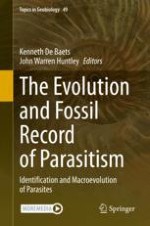2021 | OriginalPaper | Chapter
10. Evolutionary History of Crustaceans as Parasites
Authors : Joachim T. Haug, Carolin Haug, Christina Nagler
Published in: The Evolution and Fossil Record of Parasitism
Publisher: Springer International Publishing
Activate our intelligent search to find suitable subject content or patents.
Select sections of text to find matching patents with Artificial Intelligence. powered by
Select sections of text to find additional relevant content using AI-assisted search. powered by
